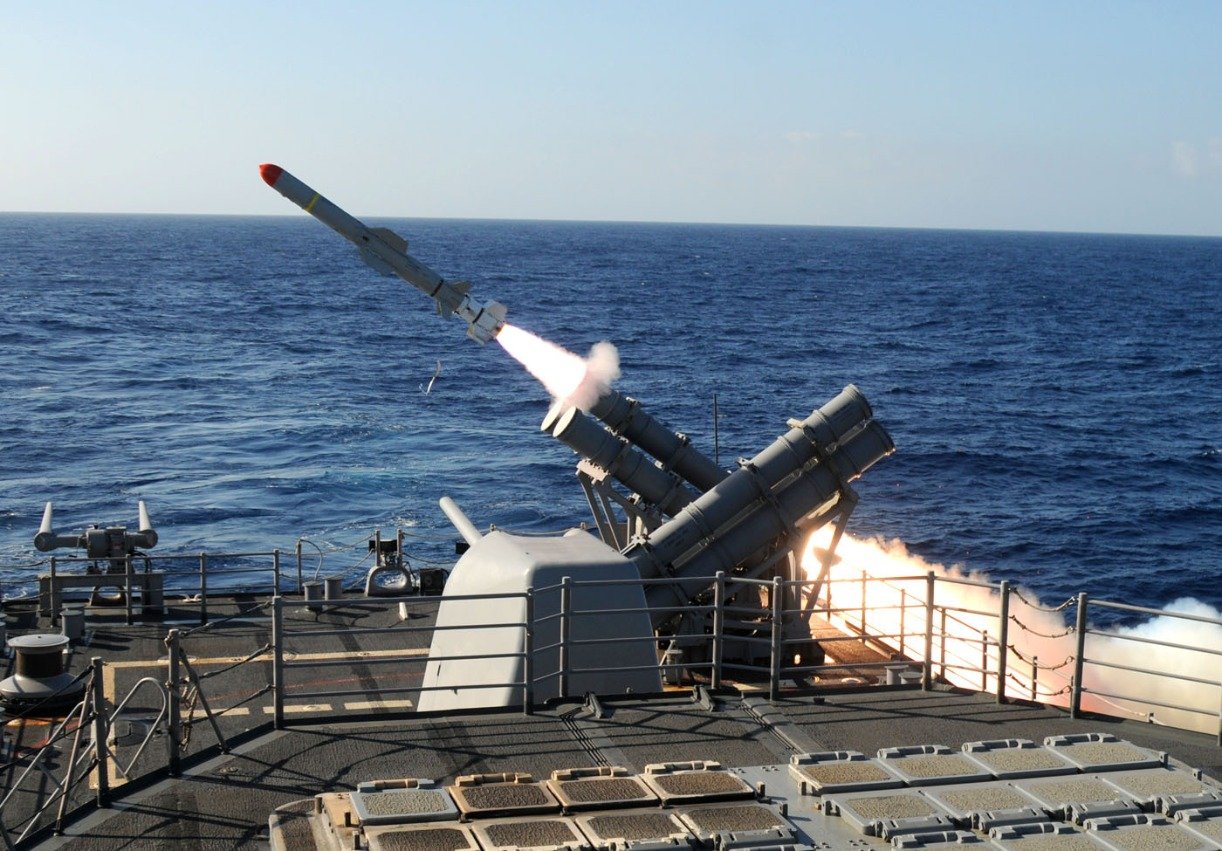Warships Destroyed: How the Harpoon Missile Keeps Sinking Everything
During recent U.S.-led naval exercises near Hawaii, the Harpoon missile demonstrated its enduring capabilities by sinking two large warships. Used by over thirty nations, this American-made anti-ship missile has been a mainstay since the Cold War.
Summary and Key Points: During recent U.S.-led naval exercises near Hawaii, the Harpoon missile demonstrated its enduring capabilities by sinking two large warships. Used by over thirty nations, this American-made anti-ship missile has been a mainstay since the Cold War.

-Developed by McDonnell Douglas in response to the 1967 sinking of the Israeli destroyer Eilat, the Harpoon features a low-level, sea-skimming cruise trajectory with active radar guidance. Various versions, including the air-launched Standoff Land Attack Missile (SLAM), have been utilized in multiple combat operations, showcasing its versatility and effectiveness.
-Despite its age, the Harpoon missile remains a formidable force in modern naval warfare.
Harpoon: A History of the Best Anti-Ship Missile Ever (According to Some Experts)
This month, two large warships were sunk by the U.S. Navy and its allies on a U.S.-led international military exercise on the Rim of the Pacific, near the Hawaiian Islands. These live-fire sinking drills included a consortium of twenty-nine nations, forty surface ships, three submarines, and roughly 25,000 personnel.
Footage of these wargames showcases the capabilities of the naval capabilities of America’s allies, namely the Royal Netherlands Navy’s De Zeven Provincien-class frigate: the proud HNLMS Tromp with its advanced, and expensive, Harpoon missiles, valued at more than $1.4 million.
These resilient, American-made, anti-ship missiles have been used by America’s allies since the days of the Cold War. These systems, while aged, did so like fine wine, as they continue to play a leading role in America’s power on the high seas. Today, the Harpoon missiles remain in service, utilized by more than thirty nations as the world’s most successful anti-ship missile available.
An Overview of the Harpoon
Conceptualization for the Harpoon peaked in the 1960s, following the shocking sinking of the Israeli destroyer Eilat during the Israeli-Egyptian war of 1967. The warship was on patrol off the coast of the Egyptian town of Port Said when a Soviet-designed P-15 Termit/SS-N-2 Styx anti-ship missile thoroughly destroyed the Israeli vessel. This attack began a new stage in naval warfare, as the first surface-to-surface missiles had sunk a warship at sea.

Militaries around the globe, including the United States, were shocked by the success of the Soviet weapon. Thick was the kick that American officials were looking for to prioritize constructing a more advanced anti-ship missile inventory. Manufacturer McDonnell Douglas was then tasked with developing the Harpoon to rectify the gap in capability.
Harpoon Missile Variants Over the Years
The first Harpoon was delivered by the end of the 1970’s. Utilizing a low-level, sea-skimming cruise trajectory with active radar guidance, capable of using both anti-ship and land-strike missiles. Following its second anniversary in the service, air-launched Harpoons were developed on the Navy’s P-3C Orion aircraft and later for use on the Air Force’s B-52H bombers. Over time, multiple Harpoon variants have been created for the platform, retaining an edge over any competitors.
The missiles could be launched from a range of systems, from surface ships and submarines to fixed-wing aircraft and coastal defense batteries. The Block 1E version of the missile, better known as the Standoff Land Attack Missile (SLAM) was first introduced in the 1990s, and the Harpoon Block II debuted in 2009.
While many Harpoon variants may differ slightly in terms of capabilities, the Block 1E (AGM-84E/SLAM) largely departs from its predecessors.
As outlined by the Center for International and Strategic Studies (CSIS), “An air-launched land attack missile, the addition of a Global Positioning System receiver, a Walleye infrared (IIR) optical guidance system, and a Maverick data-link system resulted in a significantly more precise weapon. The missile is 4.5 meters in length and 0.34 meters in diameter, with a launch weight of 628 kg. SLAM entered service in 1990 and was successfully employed in Operation Desert Storm and UN relief efforts in Bosnia.”

Since the Harpoon’s introduction to service, the anti-ship missile has been deployed in numerous combat operations. In its first decade of service, Harpoon missiles were used to sink the Iranian frigate Sahand during Operation Praying Mantis and against Libyan forces in the Gulf of Sidra.
About the Author: Maya Carlin, Defense Expert
Maya Carlin, National Security Writer with The National Interest, is an analyst with the Center for Security Policy and a former Anna Sobol Levy Fellow at IDC Herzliya in Israel. She has by-lines in many publications, including The National Interest, Jerusalem Post, and Times of Israel. You can follow her on Twitter: @MayaCarlin.
All images are Creative Commons.


